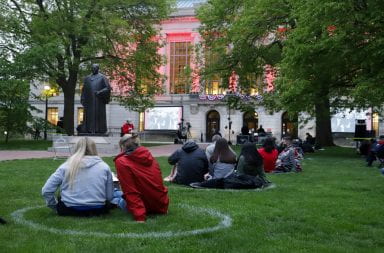Rifle fire raged across the riverbank as thousands of boys thrashed and flailed their way across the crocodile-infested waters of the Gilo River. Several were cut down and killed by Ethiopian gun squads as they tried to make it safely back into Sudan.
Two of those boys who survived years of terror and refugee camps are now students at Ohio State.
In a presentation Thursday by the John Glenn Civic Leadership Council, those Sudanese students, Simon Dau and Bol Aweng, described their forced travels between their homeland and neighboring countries of Ethiopia and Kenya.
“No child under the sun should ever go through what I have,” said Dau, who is studying international studies.
In thick accents, Dau and Aweng described their stories to about 25 awe-struck listeners.
Self-proclaimed “children of the world,” the young men are products of the vicious civil strife in Sudan between the Islamic National Front in the north and the native black tribes of the south.
Driven by the fanatical preaching of Omar Hasan Ahmad al-Bashir, the north intensified their Islamization of Sudan during the late 1980s.
To escape the genocide, about 25,000 young boys and teenagers, dubbed “The Lost Boys” by a New York Times article, were forced from their homes. They walked hundreds of miles from Sudan to refugee camps in Ethiopia, then back through Sudan to Kenya before many of them were sent to the United States by the United Nations and other groups.
During their treks, the boys were pursued by armed gunmen and had to wade across dangerous rivers, said Dau, who began his walk when he was 6 years old.
“Well you have no choice but to go in, they are on the banks shooting you and the crocodiles are in there,” Dau said.
During their cross-country walks, the boys were faced with constant danger, including starvation, dysentery, gunmen and wild animals, said Aweng, who is studying art and international studies.
“We would hold hands to make the lion believe we were one large person,” Aweng said. “But sometimes a child would be so scared that they would break the chain and run. We did not see those children again.”
Upon arrival at the refugee camps, the boys were forced to create their own infrastructure and live in intolerable conditions, Dau and Aweng said. With temperatures in the 100s and cramped conditions, children were targets for tuberculosis and whooping cough.
After several years, “The Lost Boys” were forced from their camps by the Islamic National Front. During their hasty escape, gun squads fired at the children from the southern banks of the Gilo River. Men who ran out of ammunition waded into the river and drowned children they could grab with their bare hands, according to Dau and Aweng.
At the camps in Kenya, the boys were interviewed by the U.N. and applied for evacuation to the United States. Because of lack of support, many of the refugees are still waiting for their chance to escape the genocide of their homeland, Dau and Aweng said.
Arriving in America first, they were sent to Nashville, Tennessee and placed with a family. They attended Draughons Junior College, where Aweng received an associate’s degree in fine arts and Dau in computer information and technology.
During a visit to OSU, Dau decided this was where he wanted to continue his education.
“Everything in my life has been a challenge; I can do OSU. And Bol will come too,” Dau recalled himself saying.
Patti Confar, events planner for the John Glenn School of Public Affairs, helped the two settle into Columbus and has become a motherly figure to them, providing financial and emotional support.
“They are very curious and industrious,” Confar said. “Education is their mother and their father. Education will guide them.”
Dau and Aweng said they want to create awareness about the situation in Sudan and help bring more of their brothers to the United States.
In one of his paintings, “Along the Savannah Land,” Aweng said he used shadows as a metaphor of the world’s skewed view of the situation in Sudan. The first painting he presented on Thursday showed the bottom half of three people walking, with their shadows showing a fourth unclear image.
He then showed a second painting that showed three young boys carrying a sickly child on a stretcher.
“In the shadow you do not understand what you see, but when you ask me I can show you the image of Sudan in the light,” Aweng said.
Bradley Lusenhop can be reached at [email protected].


